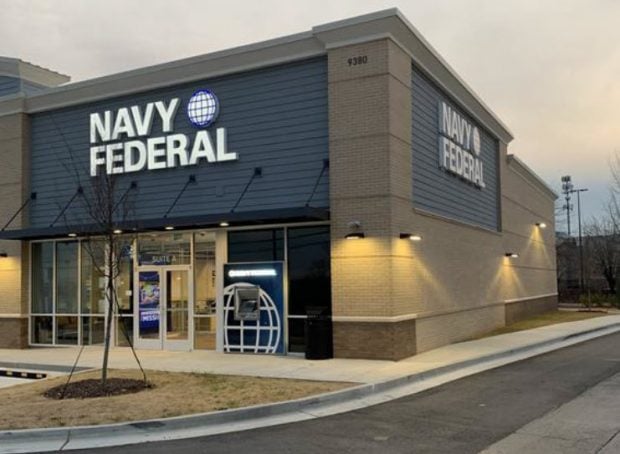 Navy Federal's newest branch opened in January in Douglasville, Ga.
Navy Federal's newest branch opened in January in Douglasville, Ga.
Navy Federal Credit Union closed some branches last year, but this year it plans to add 11, including one that opened recently west of Atlanta.
Like other credit unions, branch traffic fell off with the COVID-19 pandemic. But the nation's largest credit union kept growing during 2020, with assets rising 21.1% to reach $135.7 billion and members rising 10.8% to reach 9.9 million by Dec. 31 (membership topped 10 million in January).
Recommended For You
NCUA data shows Navy Federal had a net loss of 10 branches from September 2019 to September 2020. Navy Federal spokeswoman Brandi Gomez said many of the branches absent from the September 2020 listing were in-store branches that were closed temporarily because of the pandemic. Only two branches were closed permanently last year: one in Georgia and one in Maryland.
Richard Allen, VP of branch operations, said the lull in traffic from the pandemic allowed Navy Federal to reassess and redeploy its bricks and mortar.
"Last year was definitely a year we took a pause," Allen said. "We really wanted to evaluate the impact of the pandemic, and quite honestly what we saw was that members really weren't going to branches at the frequency they were pre-pandemic."
"That really gave us an opportunity to look at our strategy," he said.
Many credit unions cut branches last year. NCUA data shows credit unions had 21,666 branches as of Sept. 30, 290 fewer than a year earlier. However, in the previous two years, they had added 126 branches.
Navy Federal's expansion plans include three that it has not yet announced, and these eight:
- Douglasville, Ga., in the Atlanta metro area, which opened in January.
- Goose Creek, in the Charleston, S.C. metro area, to open in late February.
- Mesquite, in the Dallas metro area, to open by April.
- Burleson, in the Dallas area, to open in the second quarter.
- Fayetteville, in the Atlanta area, to open in the second quarter.
- Joint Base Pearl Harbor-Hickam in Hawaii, to open in the third quarter.
- Port Orchard, Wash., across the bay from Seattle, to open in the third quarter.
- Mansfield, in the Dallas area, to open in the fourth quarter.
"This year we're full steam ahead," he said.
The new branches will be smaller: covering about 2,700 to 3,200 square feet, compared with ones built five years ago that were up to 5,000 square feet. "The smaller branches lend to our ability to be nimble and agile."
Each will have about 10 employees. Ideally, they are experienced staff from other branches. Sometimes many will be new hires with six to eight weeks of training.
Allen wouldn't say how much Navy Federal spends on its branches, but he did discuss how it chooses where to put them.
The primary consideration is proximity to active military personnel, veterans and their families – either members or potential members.
For example, the Douglasville branch west of Atlanta has 15,000 veterans within a 20-mile radius from the branch.
"The Atlanta market is an area we have been in, but we realize there are nearly 310,000 veterans there," he said.
After it's chosen the areas it will build, it draws on its team of construction, real estate and marketing experts to find the exact location.
"Visibility is important to us, but what's even more important is accessibility," Allen said. "We look at not necessarily whether it's going to be a standalone, or an in-line, but we look at how easy is it for our members to get to this location."
And another key factor is studying members shopping patterns so it can place branches along their existing shopping routes. If a high number of them visit a Target or a Wal-Mart in the area, Navy Federal will try to find a spot nearby.
For example, the new Charleston-area branch is across the street from a Wal-Mart and half a mile from a Lowe's Home Improvement store.
Navy Federal also surveys area members about location preferences.
"We want to support our members the best way we can, and we find the best way to do that is to make their banking part of their everyday shopping, and retail habits.
In some areas, like Virginia and San Diego, it found members needed more ATMs, so it shifted to those instead of adding more branches.
And, of course, it continues to hone its online presence.
"We realize a lot of our members are going to access us in self-service channels, and we want to make sure those self-service channels are just as easy to access as our branches," Allen said.
© 2025 ALM Global, LLC, All Rights Reserved. Request academic re-use from www.copyright.com. All other uses, submit a request to [email protected]. For more information visit Asset & Logo Licensing.






